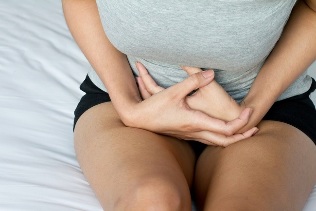At the mention of this disease as varicose veins, the majority of people imagine the pathological processes in the lower extremities, which are visible to the naked eye. Varicose veins of the small pelvis – this variety of the disease, speak and write very less. It is often considered as signs of the presence of inflammatory processes in the genital organs, some hormonal disorders, pathology of the urinary system, lumbar, sciatica.
In women varicose veins of the small pelvis caused by stretching of the vein walls, reducing their strength. Incidence peaks in the reproductive ages of 25 to 50 years. Sometimes, varicose veins can be determined in adolescent girls in a period of rapid growth and the formation of hormones and the menstrual cycle. At this age, the disease can be asymptomatic.
Another feature of pathology – tendency to worsen and active manifestation in the period of development of a child.
Signs and causes

Obstruction of the veins and faults in the system of a normal the blood circulation in the ovaries lead to alterations in the circulatory system. Provoking factor of development of the disease can be the connective tissue dysplasia, which leads to the decrease in the number of collagen and, as a consequence, the elasticity and strength of blood vessels.
Common negative factors and reasons for development of varicose veins of the small pelvis:
- pregnancy in relation to the increase in the volume of blood in the vessels, high content of progesterone, large uterine size;
- regular intense exercise;
- previous multiple pregnancy and childbirth;
- sedentary, mainly sedentary activity;
- disorders gynecological: abnormal structure of the uterus, endometriosis, inflammatory processes;
- practice for the big time withdrawal for the purpose of protection from unwanted pregnancy;
- long-term use of some methods of hormonal;
- the lack of satisfaction with sex life.
To provoke the development of varicose veins may have a hormonal imbalance, especially a rise in estrogen levels.
As already mentioned, pelvis, varicose veins can manifest in a similar way to the diseases of the reproductive system female. The main symptom that alarming, it is a constant pain. They feel the lower part of the abdomen can be weak, fragile, intense and acute. Very often, severe pain originating in the pelvis, extending to the lumbar region or sacrum. The pain becomes sharper after a physical exertion or, on the contrary, after a long stay in the same position (sitting or standing).
The following are the symptoms that manifest varicose veins of small pelvis:
- excessive bleeding after childbirth or gynecologic procedures caused by a thinning of the wall, venous to stop this bleeding difficult;
- intercourse painful, a feeling of dissatisfaction in the sexual, the fear and aversion to sex life, the appearance of a strong spasm of the muscles when it comes to intimacy;
- painful or frequent need to urinate, caused by a full-blooded bladder;
- increase the veins of the vulva or perineum, accompanied by severe itching, swelling, burning sensation;
- vein thrombophlebitis, which is characterized by inflammation or redness of the skin of the perineum, fever and General weakness.
Distinguish between varicose veins of the vulva and the development of the disease as a result of venous plethora. The disease can have three degrees of intensity.
With varicose veins:
- 1 degree – the vein diameter is 4-5 mm.
- 2 degrees – Vienna increases to 6-10 m;
- 3 degree – diameter veins more than 10 mm.
The definition of the severity of the pathology is one of the main phases of diagnosis, as that helps to determine treatment methods. In the first two cases it is usually sufficient conservative treatment, changes in diet, use of physiotherapy. Third, the severity of the disease requires surgery, the ligation of the larger veins.
During pregnancy
The disease, a problem repeatedly parous women. Changes in the veins can occur already during the first pregnancy, and with each new situation of high risk. At a certain stage of the vein bodies cease to function fully, preventing the normal outflow of blood.
The risk increases if the woman:
- diagnosed with an abnormal structure of the reproductive organs (especially the uterus);
- there is a genetic predisposition;
- the excess weight or quick set free in the course of the pregnancy;
- there are bad habits (Smoking);
- jobs that require little physical effort, long stay standing or sitting in one place.
This disease affects women in the third trimester because the growing uterus presses on nearby organs and prevents their normal activities.
The normal volume of blood circulating in the body during pregnancy increase by nearly 50 %. Not always the veins cope with an increased workload for them, especially if the situation is aggravated by various aggravating factors, which were discussed above.
Characteristic changes in the hormonal background in the body of the mother can also be bad for the elasticity of vascular walls.
Like a dangerous abnormal veins increase during pregnancy?Varicose veins of the uterus and other organs, is facing a difficult birth with serious consequences. Thin walls of the veins can be injured and even broken, causing pain and bleeding. These phenomena are harmful and dangerous not only for being women but for their life.
One of the most frequently occurring disorders – the risk of blood clots. They block the blood vessels, reducing or even preventing the normal security of the placenta with blood. This type of dysfunction leads to an aging of the placenta and oxygen starvation of the fetus.
In the 1st and 2nd stages of varicose veins of the pelvis part, as a general rule, are in a natural way. During the attempts of medical staff ensures that the low pressure in the vessel walls. The simultaneous administration of drugs that thin the blood.
Weight (3-I) form requires a cesarean section.
If you have this problem, pregnant should carefully prepare for the future of the part, that is to say:
- from the second quarter wearing prenatal bandage;
- to move actively, to avoid prolonged stay sitting or standing in one position (for example, from the computer);
- to reduce the pressure in the vessels during sleep to place between the legs of a pillow;
- access to the swimming pool or take it regularly a contrast shower.
Pregnant women need to review your diet, ensuring timely bowel movement.
Diagnosis
External pelvic examination allows you to easily identify the varicose veins of the vulva and the perineum. But how to check if a similar disease in the internal genital organs? To determine with accuracy the problem prescribe additional tests, such as ultrasound, phlebography, laparoscopy, ct scan or an MRI.
Treatment
The disease does not belong to the pathology gynecological. Your treatment by the doctor-phlebologist (vascular surgeon). But since pathology is often detected during the passage of the ultrasound, the woman observed the two specialists – a gynecologist and phlebologist. Treatment of varicose veins of the pelvis must be comprehensive, including medical therapy and treatment without drugs, the use of therapeutic exercises, the normalization of the power system and revision of the mode of the day.
Medications effectively resolve the symptoms of the initial phase. Patients prescribed the drugs in the period of exacerbation. Long-term use of these media are undesirable since they tend to cause side effects. Medications to improve circulation, reduce inflammation and pain, reduce the risk of blood clots.
As treatment of varicose veins of the pelvis in pregnant women, and how do they justify drug therapy in this case?Given the potential harm to the fetus and the high risk of side effects, drugs are prescribed not earlier than the second quarter and only in exceptional cases. If before the pregnancy the woman has never had medical problems, it is often recommended to be limited to the non-medicamental methods of therapy, for example, with the use of special underwear.
To remove the congestion in the pelvis will help you in gymnastics. The majority of the exercises performed in the position of supine. Can be known "birch", "Bicycle", "scissors". If your performance is sufficient load on the lower part of the abdomen that promote the flow of blood. Physiotherapy is complemented by the use of compression hosiery.
Among the methods of treatment used hirudotherapy, leech therapy, which I put in the coccyx.
Folk remedies
The traditional medicine is effective to overcome the symptoms of the disease, when applied in the early stages. Great efficiency, teas and herbal teas, broths of the fungus and the root of the dandelion, dyeing on the basis of horse chestnut.
The most affordable way to use chaga – tea is based on it. To do this, 3 tablespoons of dried chaga pour 0.5 liters of boiled water and insist in a warm place for several hours. Take half an hour before meals 2-3 times a day.
Dessert spoon of crushed roots of dandelion pour a glass of boiled water for a couple of hours and drink three times a day 10-15 minutes before eating. This tea is contraindicated for people suffering from gastritis or disease of the bile ducts.
To prepare the tincture of the horse chestnut fruit skin of the skin, finely chop, put in a bottle of dark glass and pour vodka in the ratio of 1:10. The duration of the infusion – 14 days. 25-30 drops of the tincture obtained is mixed with a small amount of water and take three times a day. The duration of consumption should not exceed 30 days.
The diet

Of great importance in the treatment of the disease is a balanced diet excluding fatty foods and alcoholic beverages. The menu should include meals with a high content of fiber, fats of vegetable origin. The main products in the diet should be vegetables, fruits, natural juices, green tea. It is not recommended for sweet pastry, dishes with lots of spices, fast food. The meals should be frequent, but in small portions.
Useful products with a high content of vitamin C (citrus, blackcurrant), fish and seafood (oysters, shrimp, seaweed). The dishes you need for cooking, with a minimal amount of salt.
Prevention
Conservative therapies significantly facilitate the condition of patients and eliminate the risk of serious consequences. The main goal of treatment is to prevent relapse and the need for surgical intervention. Of great importance is the prevention of the disease and its recurrence.
Between medical recommendations, should be highlighted:
- To use hormonal drugs only on prescription and under his control.
- To have an active lifestyle with moderate exercise.
- Eliminate bad habits such as Smoking and consumption of alcoholic beverages.
- Regularly perform complex gymnastics exercises to support vascular health.
- Follow a healthy diet with plenty of vegetables and fruits.
- Wear compression tights when the first signs of varicose veins.
The application of the recommendations of preventive action is also important during pregnancy, especially in its second half.
Review of the nutrition, active lifestyle, regular visits to the doctor, the treatment of varicose veins of the pelvis immediately after the detection of the disease will eliminate the painful symptoms and avoid surgery for a long time.




































